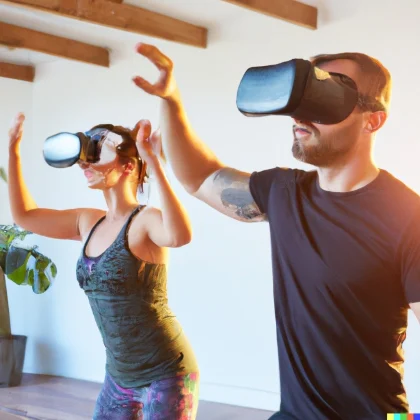Technology has revolutionized the way people approach home workouts, making the experience more convenient, interactive, and effective. With the rise of smart fitness equipment, workout apps, and virtual training programs, individuals now have access to a wide range of tools and resources to enhance their exercise routines. These advancements have transformed the traditional home workout experience, allowing users to track their progress, receive personalized guidance, and stay motivated from the comfort of their own space.
Many individuals are curious about the impact of virtual reality (VR) and augmented reality (AR) on home workouts. These immersive technologies have the potential to transport users to virtual environments, providing an engaging and dynamic workout experience. Additionally, wearable devices and fitness trackers have gained popularity for their ability to monitor various aspects of one’s fitness journey, such as heart rate, calories burned, and sleep patterns. Moreover, interactive online communities and live streaming workout classes offer a sense of connection and accountability, further enhancing the home workout experience.
Virtual Reality Fitness
Virtual reality (VR) technology has revolutionized the home workout experience by providing immersive and engaging fitness activities. With VR fitness programs, users can participate in interactive workouts that simulate real-life environments, such as hiking trails, dance studios, or even boxing rings. This technology not only makes exercise more enjoyable but also allows users to escape the confines of their home and explore new, exciting workout settings.
Additionally, VR fitness programs often incorporate gamification elements, such as point systems and challenges, to motivate users and enhance their overall experience. This combination of immersive environments and gamification helps individuals stay committed to their fitness routines and achieve their health goals from the comfort of their own homes.
Smart Connected Equipment
Advancements in technology have led to the development of smart connected fitness equipment, such as treadmills, stationary bikes, and strength training machines. These devices are equipped with sensors and connectivity features that allow users to track their workouts, monitor their progress, and access interactive training programs. Through integrated touchscreen displays or mobile apps, individuals can engage in virtual classes, receive personalized coaching, and compete with others in online fitness challenges.
Furthermore, smart connected equipment often syncs data to fitness apps and wearable devices, providing users with comprehensive insights into their exercise habits and performance. This seamless integration of technology not only enhances the convenience of home workouts but also enables individuals to optimize their training regimens based on real-time feedback and analytics.
On-Demand Workout Streaming
On-demand workout streaming services have become increasingly popular, offering a vast library of exercise videos and live classes that can be accessed anytime, anywhere. Whether it’s yoga, HIIT, dance cardio, or strength training, individuals can choose from a wide range of workouts to suit their preferences and fitness levels. These platforms also feature diverse instructors and training styles, allowing users to explore different disciplines and find routines that resonate with them.
Moreover, many on-demand workout services utilize personalized recommendation algorithms to suggest tailored exercise programs based on individual interests and previous activity. This level of customization, combined with the convenience of streaming workouts on various devices, empowers people to create diverse and engaging home fitness experiences that align with their specific goals and schedules.
Interactive Fitness Apps
Interactive fitness apps have transformed the way people approach home workouts by offering dynamic and interactive training experiences. These apps provide a wide array of features, including workout tracking, guided exercises, progress monitoring, and community engagement. Users can access structured workout plans, follow along with video demonstrations, and receive audio cues to optimize their performance and form.
Furthermore, many interactive fitness apps incorporate social elements, such as leaderboards, challenges, and group competitions, fostering a sense of community and accountability among users. This social connectivity not only motivates individuals to stay consistent with their workouts but also creates a supportive environment where they can share their achievements and interact with like-minded fitness enthusiasts.
Personalized Virtual Coaching
Technology has enabled the rise of personalized virtual coaching services, allowing individuals to receive tailored guidance and support from certified fitness professionals without leaving their homes. Through video calls, messaging platforms, and specialized coaching apps, users can connect with coaches who create customized workout plans, offer nutritional advice, and provide accountability to help individuals stay on track with their health and fitness goals.
Moreover, personalized virtual coaching often involves the use of wearable devices and fitness trackers to monitor clients’ activity levels, sleep patterns, and overall well-being. This data-driven approach enables coaches to make informed decisions and adjustments to their clients’ programs, ensuring that they receive personalized attention and guidance throughout their fitness journey.
AI-Powered Workout Recommendations
Artificial intelligence (AI) technology has been integrated into fitness platforms to deliver personalized workout recommendations based on individual preferences, performance data, and fitness goals. By analyzing user behavior and feedback, AI algorithms can suggest specific exercises, training intensities, and recovery strategies that align with each person’s needs and capabilities. This tailored approach helps individuals optimize their workouts and progress more efficiently towards their desired outcomes.
Furthermore, AI-powered workout recommendations continuously adapt and evolve as users engage with different fitness activities and provide input on their experiences. This iterative process of learning and refinement ensures that individuals receive relevant and effective workout suggestions that evolve in tandem with their changing fitness levels and aspirations.
Biofeedback and Performance Tracking
Advancements in biofeedback technology have enhanced the home workout experience by enabling individuals to monitor their physiological responses and performance metrics in real time. Wearable devices, such as heart rate monitors, smartwatches, and fitness trackers, allow users to track vital signs, calories burned, and workout intensities throughout their exercise sessions. This biofeedback data provides valuable insights into the effectiveness of workouts and helps individuals make informed decisions about their training approaches.
Moreover, biofeedback and performance tracking technology often syncs with fitness apps and platforms to visualize and analyze workout data, enabling users to gain a deeper understanding of their progress and trends over time. By leveraging this information, individuals can adjust their training variables, set new targets, and make evidence-based adjustments to their routines, ultimately optimizing their home workout experiences for better results.
Immersive Audio Experiences
Immersive audio experiences have become an integral part of the home workout landscape, leveraging technologies such as surround sound, binaural audio, and personalized soundscapes to create engaging and motivating environments for exercise. By using headphones or speakers, individuals can immerse themselves in high-quality audio content, such as motivational coaching, energizing music playlists, and interactive sound effects that complement their workout routines.
Furthermore, immersive audio experiences can be tailored to individual preferences, allowing users to customize their sound environments based on their workout activities and personal tastes. Whether it’s a virtual running coach providing real-time encouragement or a curated playlist that synchronizes with specific exercise intervals, immersive audio technologies enhance the home workout experience by elevating motivation, focus, and enjoyment during training sessions.
| Technology | Enhancement |
|---|---|
| Wearable Fitness Trackers | Provide real-time data on heart rate, calories burned, and workout intensity |
| Fitness Apps | Offer personalized workout plans, virtual coaching, and progress tracking |
| Smart Home Gym Equipment | Integrate with apps to track performance, provide interactive workouts, and adjust settings automatically |
| Virtual Reality Fitness | Immersive and interactive workout experiences that make exercising at home more engaging |
| Online Workout Classes | Access to live and on-demand classes with professional instructors from the comfort of home |
Technology is enhancing the home workout experience by providing real-time data, personalized guidance, interactive workouts, and access to professional instruction, making it more convenient, engaging, and effective for individuals to exercise at home.



